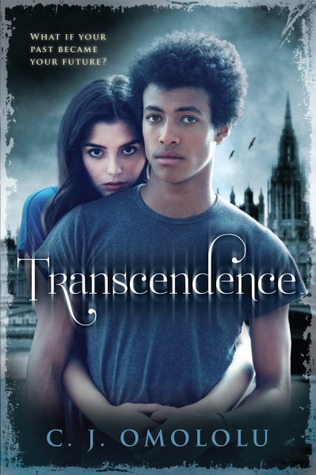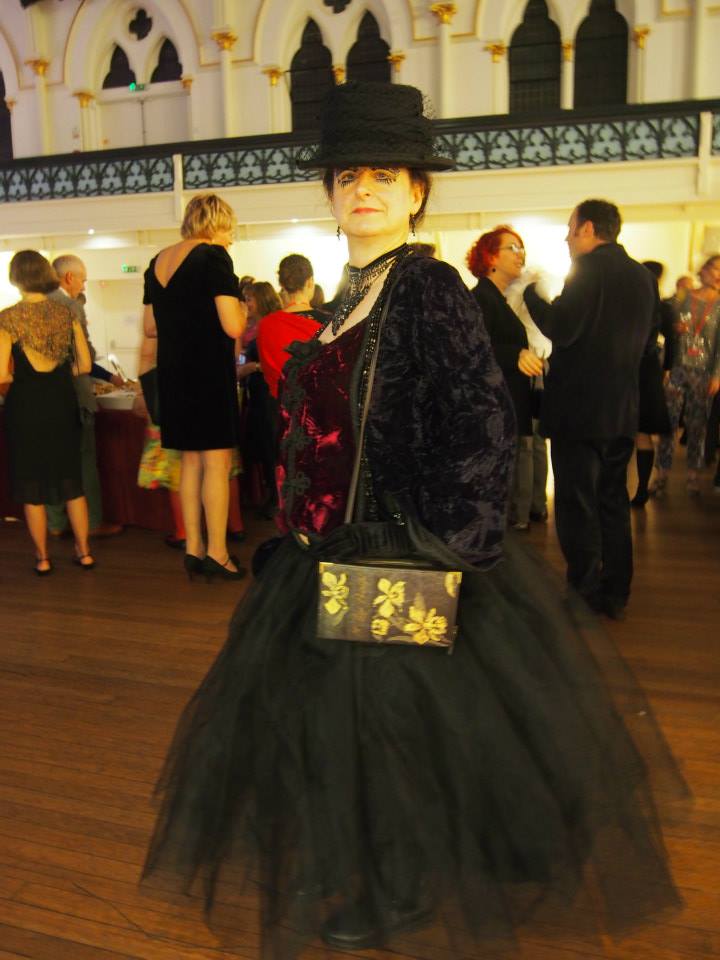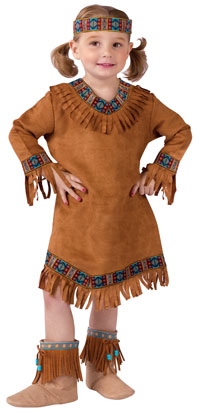There are few things I like better than dressing up. I have gilded memories of the costumes my immensely talented Nanna made for me and the Halloween theme at this year’s SCBWI Conference was a gift for me.
I also loved dolls with national costumes: I so yearned after a glossy satin Flamenco dancer in the Canary Isles, it hurt. I sought out books and my childish heart went out to those scenes with Children of the World linking hands. I confess: I went all gooey in ‘It’s a Small World’ at Disneyland.
Rarely have I been happier than when my Aunt from the US brought me a cowboy outfit – and a bow-and-arrow set. What I really really wanted was a Tiger Lily outfit, though: eagle feather head dress and everything. Now, I understand, costumes are a subject of dispute. Is it OK to wear a Native American outfit if you’re white? Part of me is very sad if it isn’t.
When I wore my Flamenco dress that Nanna created out of a shiny underskirt and red felt roses, I was Spanish. I had a fan and high heels and my hair piled up with a comb and a lace veil in it. This version of me was haughty and grown-up. I don’t think I was looking down on anyone Hispanic – rather, wistfully yearning to be them.
The same goes for the beautiful women from all over the world I saw in films and cartoons and illustrations. I’ve been a ‘South Sea Islander’ from South Pacific, a Russian Princess and Heaven knows what else out of the dressing-up box. I used to draw children in national costumes – and was ever so disappointed England didn’t really have one.
I do understand they were stereotypes. I know there is far more depth and variety to any aspect of Chinese culture than, say, Lin Tang the splendidly villainous daughter of Fu Manchu or much more to say about black women than Lieutenant Uhura. Yet they were characters I loved to be – and they weren’t white.
It’s a similar issue with books. I wholeheartedly want there to be more diverse books in every possible dimension. Long ago I took on the teaching:
Be the change that you wish to see in the world.
― Mahatma Gandhi
I must be open to characters of any kind in my work.
A few years back, after a visit to the National Maritime Museum, a young black man ‘asked’ to be part of my Work-in-Progress. I wanted to do the right thing – so I went to the top: I asked Malorie Blackman.
‘Treat him with the same respect you would any other character,’ she said, ‘ do your research.’
So I did. And I learned all sorts of wonderful, terrible and unexpected stories. As it happened, Abednego took a bow – though he waits for his own story, I think. But one thing really stuck with me – the criticism of white writers, film-makers and so on who tried to show anyone who wasn’t the same as them.
I have absolutely no doubt that much is deserved reproof. I am braced to accept that I am over-sensitive, and that as a privileged, white woman [ oh do I hate those labels!] I haven’t a an angsty middleclass leg to stand on. Yet, to be frank and vulnerable, it put me right off trying.
I had no intention of tokenism, cultural imperialism or recreating Magic Negro stereotypes: I didn’t know what they were. The more I read, the more confused I became – and the more worried. The bolder part of me wanted to carry on regardless. Everyone has the same sort of lungs and spleen and tendons whatever shade of skin they bear – so they feel the same beneath, surely?
Yet I also knew that a person’s background shapes those feelings and how they are manifest. I just didn’t want to get it wrong. So I suppose I ducked it. When I reckoned up the gender balance and there were far too many male characters, Abednego disappeared. I miss him.

Portrait of Olaudah Equiano
Three key incidents confirmed my decision. Early on, I watched Rich Hall’s fascinating documentary ‘Inventing The Indian.’ Sadly, it’s not currently on i-player, though there’s a clip to give you a flavour. The main thread was how the media’s portrayal of Native American Peoples has born so little resemblance to their own truth. I knew some of this and learnt more.
Then the presenter got to ‘Thunderheart‘. He tore into it and I felt distraught. I had loved the film and OK, rather belatedly, it had made me respect Sioux culture. Was my judgement so crap? Had I no idea about anyone else but my narrow community?
Second was reviewing ‘Ghost Hawk’ by Susan Cooper. Although the book has its flaws, I thought the Pokonoket Indian boy’s journey to manhood both bold and fascinating. I mentioned this to a friend – whom I really, really respect. I think she would describe herself as ‘a person of colour’. She was not impressed. My mouth closed. My heart sank. How could I have got it so very wrong?
The third was another writer friend. She had been shortlisted in a competition promoting diversity. She had said how disappointed and small she felt when she went onto the stage for the awards. There in front was a sea of hopeful faces of every colour – but on the stage, the writers were all the same: white.
Neither she nor I can help our family background. I truly, truly wish there to be more diverse books written by more diverse authors – featuring characters of every stripe. And these books shouldn’t be shoved into a worthy-and-improving ghetto.

Griffon on the front
It’s perhaps only a small thing but I was enraged by the difference in the two covers for a book I was writing about for Serendipity Reviews – ‘Transcendence’ by CJ Omololu. One clearly showed the mixed heritage [am I even supposed to say that?] love interest – but the other ditched him. Being seen is crucial. Books are both windows – and mirrors.

white-washed cover
So that leaves me with a big question to which I have no answer. Is it better to have more characters from different backgrounds which are not that well done – or a fewer that portray cultures more accurately?
For myself, I tend towards the better-a-bit-of-a-caricature-than-nothing camp. Stalking invisible elk in plastic beaded moccasins is better than never trying at all.
You may well have different view – I would welcome the debate.
Some resources you might enjoy too:
An illustrated guide to writing people of color
Long list of History’s greatest Black achievers.
Happy to add more – just tell me in the comments.



Just typed a much more considered comment and lost it!
Of course we can and must write outside our own experience – I would be stuck with welsh jamaicans! When I wrote a London Bangladeshi girl i made sure I had a sixth form full of readers as I went along to keep me on the straight and narrow. As Malorie says – research!
And as to being ‘done ‘ badly. Imagine this – the only British characters you EVER read as Dick Van Dyke all the time! Now I know most Hollywood baddies are brits but we’ve had a long time in the driving seat of popular culture so we can take a few knocks, but if you’ve always been the butt of the joke, the idiot, or if you’re lucky the best friend who dies first it is no fun at all.
So YES PLEASE lets all write outside our comfort zones once in a while lets write stories with all sorts of people because the reason stories work after all is that under the skin we are pretty much the same. So let’s do our research and get things right.
On the dressing up – I must agree it’s a sort of end of naivety, but these days we (I hope) would not dress up as Nazis or in blackface would we? Wouldn’t we? And think how much cultural appropriation those North Americans have suffered. Shouldn’t they be able to make the rules about it now?
xc
Thank you so much for commenting, Catherine. much appreciated. Practical and supportive as ever.
Re the dressing-up , especially for children, I think I have failed to make a broader point. If another people’s culture is ‘off-limits’ then those people become very definitely ‘other’. This usually does not end well. Children in the throes of imaginary play won’t notice if the firefighter’s uniform is wrong – or the Cheyenne warrior’s – but they’d benefit from the chance to be those people for a while. [Don’t get me started on princess costumes!]
🙂
Thanks for the interesting discussion … When I was a child in 1950s Australia my grandfather travelled worldwide & always brought me back a doll in ‘national costume’ which along with stamps he gave me from his international post, provided a window into the world for me. Before our house burnt down when I was 11, I had over 100 dolls of all colours and I loved them! I made no distinction between the Fijian islander police doll and the British Bobby, the ‘Siamese’ dancers, and the Spanish Flamenco dancer – they all peopled what I saw as a fascinating world outside Australia. Colour, costume, exotic names and places I would look up in an atlas – this is what I remember particularly! I was devastated when they went up in flames and 50 years on I still think of them. My love of travel and difference, exploring and immersion in other worlds stems from those dolls and my grandfather’s travels. Now as I work on a book about his family growing up on an island in the Pacific, I encounter people of different times and their attitudes to others – islanders, foreigners – and to the natural world which I find sometimes hard to bear or understand. Immersing yourself in another time & place is often uncomfortable but also an adventure! So too depicting people who are not ourselves!
Oh, how fascinating – and it rather proves one of my better points. Children becoming other people through imaginative play or reading does them a world of good. Thank you so much for taking time to comment, Lesley.
I agree with Catherine Johnson. We should, all, be able to write about people from other cultural backgrounds if that is important to the story we are writing. But it’s imperative to get it right, do the research, and seriously respect the culture we are writing about. Otherwise we run the risk of simply proliferating stereotypes even when we mean well. Also, we need the humility to accept criticism – because we may not have got it right after all.
Tough, eh? I know.
I agree – especially about the humility! Thanks for commenting, Katherine.
I know exactly how you feel, because I’ve been equally sheepish when it comes to writing about characters from different backgrounds. One of the joys of diverse books for me is experiencing the characters’ family life, social customs etc. in ways that are both similar and different to mine. And I feel that I lack the knowledge that an indigenous author would be able to effortlessly bring to such scenes. So my characters often end up rather white, middle-class and somewhat stodgy.
Yet, just last week, I had the idea for a story where the context demanded that the main character be a black girl from the Southern U.S.A. I screwed up my courage, did my research and I think it’s the single best thing I’ve ever written. It’s good to lean out of your comfort zone sometimes!
Oh bravo, Nick. Sounds good – and thank you for commenting. It’s lovely to get feedback from people you respect
🙂
Good luck with your cultural explorations. I was also petrified for years about writing female protagonists (especially because I mainly work in first-person), but since I shook that off the results have been pretty good, I think.
It is essential that we write from a diverse point of view otherwise we would be stuck in our own small worlds. When I began my debut novel set in Fife, a black West African woman arrived on the page and said ‘tell my story’. I resisted for a long time but in the end she won. I researched and researched, but I also worried about appropriating someone else’s life. I worried through the publication process and then I ask two African men living in Scotland to read the MS. They both loved it, contributed quotes and have been great supporters. It was a risk that paid off. I think as writers we should always be prepared to take that risk but also be mindful of the pitfalls. M
Thanks for commenting, Moira. I love how your character insisted!
Pingback: Ten-Minute Blog Break – 18th November | Words & Pictures